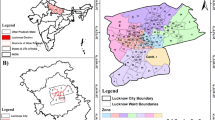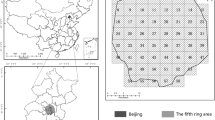Abstract
The present study was aimed to investigate how and to what extent urban land surface temperature (ULST) is affected by spatial pattern of green cover patch in an urban ambient in Isfahan, Iran. To materialize the effects of spatial pattern of green cover on ULST, Landsat ETM + image data on May 5, 2002 was acquired to be processed for ULST estimation and to generate Land Use/Land Cover (LULC) classes. Given to five percent of total available cells with a randomized distribution across the built-up areas, the linkage between ULST and composition, configuration and structure of green cover class was quantified. Five patch level landscape metrics including nearest distance (ND), patch area (AREA), perimeter to area (PARA), shape index (SHAPE) and core area index (CAI) were chosen and applied as explaining variables in statistical analyses due to their potential effects on ULST. Results of the present study have revealed that all the landscape metrics values of the green cover class were significantly correlated to their nearest ULST sample points, amongst which a stronger linkage was observed between ND (r = 0.611, p <0.05) and ULST compared to others. Stepwise generalized additive modeling method-based multiple linear regression model was then fitted to dataset and resulted in developing the model (r2 = 0.41, p <0.05), explaining the relationship between spatial pattern of green cover and ULST. Finally, we concluded that the present study could provide additional level of knowledge through which urban planners can optimize composition, configuration and structure of green cover patches to mitigate the adverse impacts of LST phenomenon especially where urbanization is still ongoing.






Similar content being viewed by others
References
Akbari H, Pomerantz M, Taha H (2001) Cool surfaces and shade trees to reduce energy use and improve air quality in urban areas. Sol Energy 70(3):295–310
Amiri BJ, Nakane K (2009) Modeling the linkage between river water quality and landscape metrics in the Chugoku district of Japan. Water Resour Manag 23(5):931–956
Anderson JR, (1976) A land use and land cover classification system for use with remote sensor data, vol 964. US Government Printing Office
Arnfield AJ (2003) Two decades of urban climate research: a review of turbulence, exchanges of energy and water, and the urban heat island. Int J Climatol 23(1):1–26
Aronoff (2004) Remote sensing for GIS managers. Environmental Systems Research
Asgarian A, Shafiezadeh M, Amiri BJ (2013) Assessing the relationship between urban heat island and spatial pattern of LULC classes using landscape ecology approach, First international conference of IALE-Iran. Iran, Isfahan
Barnes KB, Morgan III JM, Roberge MC, Lowe S (2001) Sprawl development: its patterns, consequences, and measurement. Towson University, Towson:1–24
Beyer HL (2004) Hawth’s analysis tools for ArcGIS. URL: http://www.spatialecology.com/htools (Last date accessed: 17 June 2010)
Cao X, Onishi A, Chen J, Imura H (2010) Quantifying the cool island intensity of urban parks using ASTER and IKONOS data. Landsc Urban Plan 96(4):224–231
Chander G, Markham BL, Helder DL (2009) Summary of current radiometric calibration coefficients for Landsat MSS, TM, ETM+, and EO-1 ALI sensors. Remote Sens Environ 113(5):893–903
Chatterjee S, Hadi AS, Price B (2000) The use of regression analysis by example. Wiley, New York, USA
Cui L, Shi J (2012) Urbanization and its environmental effects in Shanghai. China, Urban Climate
Deng JS, Wang K, Hong Y, Qi JG (2009) Spatio-temporal dynamics and evolution of land use change and landscape pattern in response to rapid urbanization. Landsc Urban Plan 92(3):187–198
Gillespie A, Rokugawa S, Matsunaga T, Cothern JS, Hook S, Kahle AB (1998) A temperature and emissivity separation algorithm for advanced Spaceborne thermal emission and reflection radiometer (ASTER) images. IEEE Geosci Remote Sens 36(4):1113–1126
Herzog F, Lausch A, Muller E, Thulke H-H, Steinhardt U, Lehmann S (2001) Landscape metrics for assessment of landscape destruction and rehabilitation. Environ Manag 27(1):91–107
Hun G, Xu J (2012) Land surface phenology and land surface temperature changes along an urban–rural gradient in Yangtze River Delta, China. Environ Manag 52:234–249
Iranian Bureau of Statistics (2010). Statistical yearbook of Isfahan province. URL: http://www.amar.org.ir/Default.aspx?tabid=667&fid=11275 salname-02-98.pdf (Last date accessed: 16 April 2013)
Kalnay E, Cai M (2003) Impact of urbanization and land-use change on climate. Nature 423(6939):528–531
Kim J, Zhou X (2012) Landscape structure, zoning ordinance, and topography in hillside residential neighborhoods: a case study of Morgantown, WV. Planning, Landscape and Urban
Kolokotroni M, Giannitsaris I, Watkins R (2006) The effect of the London urban heat island on building summer cooling demand and night ventilation strategies. Sol Energy 80(4):383–392
Liu H, Weng Q (2009) Scaling effect on the relationship between landscape pattern and land surface temperature: a case study of Indianapolis, United States. Photogramm Eng Remote Sens 75(3):291–304
McFeeters S (1996) The use of the normalized difference water index (NDWI) in the delineation of open water features. Int J Remote Sens 17(7):1425–1432
McGarigal K, Marks BJ (1995) Spatial pattern analysis program for quantifying landscape structure. Gen Tech Rep PNW-GTR-351 US Department of Agriculture, Forest Service, Pacific Northwest Research Station
McGarigal K, Compton B, Jackson SD, Rolih K, Ene E (2005) Conservation assessment a prioritization system (CAPS). Final report, Landscape ecology program. Department of Natural Resources Conservation, University of Massachusetts, USA
McKinney ML (2002) Urbanization, biodiversity, and conservation: the impacts of urbanization on native species are poorly studied, but educating a highly urbanized human population about these impacts can greatly improve species conservation in all ecosystems. Bioscience 52(10):883–890
Mitsova D, Shuster W, Wang X (2009) A cellular automata model of land cover change to integrate urban growth with open space conservation. Landsc Urban Plan 99(2):141–153
Mondal P, Southworth J (2010) Evaluation of conservation interventions using a cellular automata-Markov model. For Ecol Manag 260(10):1716–1725
Nafstad P, Håheim LL, Wisløff T, Gram F, Oftedal B, Holme I, Hjermann I, Leren P (2004) Urban air pollution and mortality in a cohort of Norwegian men. Environ Health Perspect 112(5):610
Qin ZH, Karnieli A, Berliner P (2001). A mono-window algorithm for retrieving land surface temperature from Landsat TM data and its application to the Israel-Egypt border region. Int J Remote Sens 22(18), 3719–3746
Rutledge (2003) Landscape indices as measures of the effects of fragmentation: can pattern reflect process
Shafagi S (2001) The geography of Isfahan. Technology publication, Isfahan University of (in persian)
Shao M, Tang X, Zhang Y, Li W (2006) City clusters in China: air and surface water pollution. Front Ecol Environ 4(7):353–361
Sobrino JA, Jiménez CJ Paolinib M (2004) Land surface temperature retrieval from LANDSAT TM 5. Remote Sens Environ 90:434–440
Sobrino J, Li Z, Stoll M, Becker F (1996) Multi-channel and multi-angle algorithms for estimating sea and land surface temperature with ATSR data. Int J Remote Sens 17(11):2089–2114
Soffianian A, Nadoushan MA, Yaghmaei L, Falahatkar S (2010) Mapping and analyzing urban expansion using remotely sensed imagery in Isfahan, Iran. World Applied Sciences J 9(12):1370–1378
Takebayashi H, Moriyama M (2007) Surface heat budget on green roof and high reflection roof for mitigation of urban heat island. Build Environ 42(8):2971–2979
Tang J, Wang L, Yao Z (2008) Analyses of urban landscape dynamics using multi-temporal satellite images: a comparison of two petroleum-oriented cities. Landsc Urban Plan 87(4):269–278
Teemusk A, Mander Ü (2009) Greenroof potential to reduce temperature fluctuations of a roof membrane: a case study from Estonia. Build Environ 44(3):643–650
Voogt JA, Oke TR (2003) Thermal remote sensing of urban climates. Remote Sens Environ 86(3):370–384
Weng Q (2001) Modeling urban growth effects on surface runoff with the integration of remote sensing and GIS. Environ Manag 28(6):737–748
Weng Q, Lu D, Schubring J (2004) Estimation of land surface temperature–vegetation abundance relationship for urban heat island studies. Remote Sens Environ 89(4):467–483
Weng Q, Liu H, Lu D (2007) Assessing the effects of land use and land cover patterns on thermal conditions using landscape metrics in city of Indianapolis, United States. Urban ecosystems 10(2):203–219
White MA, Nemani RR, Thornton PE, Running SW (2002) Satellite evidence of phenological differences between urbanized and rural areas of the eastern United States deciduous broadleaf forest. Ecosystems 5(3):260–273
Xiao J, Shen Y, Ge J, Tateishi R, Tang C, Liang Y, Huang Z (2006) Evaluating urban expansion and land use change in Shijiazhuang, China, by using GIS and remote sensing. Landsc Urban Plan 75(1):69–80
Xie M, Wang Y, Chang Q, Fu M, Ye M (2013) Assessment of landscape patterns affecting land surface temperature in different biophysical gradients in Shenzhen, china. Urban Ecosystems 16:871–886
Zhang XY, Friedl MA, Schaaf CB, Strahler AH, Schneider A (2004) The footprint of urban climates on vegetation phenology. Geophys Res Lett 31, L12209
Zhang X, Zhong T, Feng X, Wang K (2009) Estimation of the relationship between vegetation patches and urban land surface temperature with remote sensing. Int J Remote Sens 30(8):2105–2118
Zhou W, Huang G, Cadenasso ML (2011) Does spatial configuration matter? Understanding the effects of land cover pattern on land surface temperature in urban landscapes. Landsc Urban Plan 102(1):54–63
Author information
Authors and Affiliations
Corresponding author
Rights and permissions
About this article
Cite this article
Asgarian, A., Amiri, B.J. & Sakieh, Y. Assessing the effect of green cover spatial patterns on urban land surface temperature using landscape metrics approach. Urban Ecosyst 18, 209–222 (2015). https://doi.org/10.1007/s11252-014-0387-7
Published:
Issue Date:
DOI: https://doi.org/10.1007/s11252-014-0387-7




